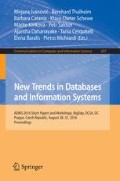Abstract
Multi-model utilisation is a common practice in many sciences, e.g. computer science. Coherence and co-evolution of models is however still an open problem. Multi-model approaches suffer however from the impedance mismatch due to differences in modelling languages. The collaboration approach is based on preservation of local models and on explicit association of derived sub-models. Each discipline has developed its specific know-how in modelling and model deployment. Models evolve in dependence on the progress of the research work. If a model or one of its sub-models has been exchanged with a team member then this evolution must also be applied to models of the partner if those sub-models are used elsewhere.
We develop a novel approach to multi-model development and utilisation, to common use and utilisation of models and modelling experience, to systematic assessment of models and systematic extraction of the potential and capacity of models for a research community, and to the co-evolution of model networks.
Access this chapter
Tax calculation will be finalised at checkout
Purchases are for personal use only
Notes
- 1.
This restriction can be weakened if additional identification auxiliaries are used.
References
Börger, E., Stärk, R.: Abstract State Machines - A Method for High-Level System Design and Analysis. Springer, Berlin (2003)
Coleman, A.: Scientific models as works. Cataloging Classif. Q. Spec. Issue: Works Entities Inform. Retrieval 33, 3–4 (2006)
Dahanayake, A., Thalheim, B.: Co-evolution of (information) system models. In: Bider, I., Halpin, T., Krogstie, J., Nurcan, S., Proper, E., Schmidt, R., Ukor, R. (eds.) BPMDS 2010 and EMMSAD 2010. LNBIP, vol. 50, pp. 314–326. Springer, Heidelberg (2010)
Dirks, U., Knobloch, E. (eds.): Modelle. Peter Lang (2010)
Fleck, L.: Denkstile und Tatsachen. In: Werner, S., Zittel, C. (eds.) Surkamp (2011)
Fleischer, D., Jannaschk, K.: A path to filled archives. Nat. Geosci. 4, 575–576 (2011)
Förster, F., Thalheim, B.: An effectual approach for a data and information management for humanists. Qual. Quant. Methods Libr. (QQML) 2, 121–128 (2012)
Gillett, N.P., Zwiers, F.W., Weaver, A.J., Hegerl, G.C., Allen, M.R., Stott, P.A.: Detecting anthropogenic influence with a multi-model ensemble. Geophys. Res. Lett. 29(20), 31–34 (2002)
Goguen, J.: Three perspectives on information integration. In: Kalfoglou, Y., et al. (eds.): Semantic Interoperability and Integration. Dagstuhl Seminar Proceedings 04391 (2005)
Gray, J., eScience: A transformed scientific method. Technical report, Talk given Jan 11, Edited by Hey, T., Tansley, S., Tolle, K. (2007). http://research.microsoft.com/en-us/um/people/gray/talks/NRC-CSTB_eScience.ppt, Microsoft Research Publications
Guerra, E., de Lara, J., Kolovos, D.S., Paige, R.F.: Inter-modelling: from theory to practice. In: Petriu, D.C., Rouquette, N., Haugen, Ø. (eds.) MODELS 2010, Part I. LNCS, vol. 6394, pp. 376–391. Springer, Heidelberg (2010)
Halloun, I.A.: Modeling Theory in Science Education. Springer, Berlin (2006)
Holst, F.: Konzeptuelle Sichten. Master’s thesis, CAU Kiel, Institut für Informatik, Kiel, Juli 2015
Hunter, P.J., Li, W.W., McCulloch, A.D., Noble, D.: Multiscale modeling: physiome project standards, tools, and databases. IEEE Comput. 39(11), 48–54 (2006)
Jaakkola, H., Thalheim, B.: Multicultural adaptive systems. In: Information Modelling and Knowledge Bases XXVI. Frontiers in Artificial Intelligence and Applications, vol. 272, pp. 172–191. IOS Press (2014)
König, H.: Protocol Engineering: Prinzip. Beschreibung und Entwicklung von Kommunikationsprotokollen. Teubner, Stuttgart (2003)
Lenz, H.-J., Thalheim, B.: A formal framework of aggregation for the OLAP-OLTP model. J. UCS 15(1), 273–303 (2009)
Magnani, L., Carnielli, W., Pizzi, C. (eds.): Model-Based Reasoning in Science, Technology: Abduction, Logic, and Computational Discovery. Springer (2010)
Malzew, A.I.: Algebraic Systems. Nauka, Moscow (1970)
Pardillo, J.: A systematic review on the definition of UML profiles. In: Petriu, D.C., Rouquette, N., Haugen, Ø. (eds.) MODELS 2010, Part I. LNCS, vol. 6394, pp. 407–422. Springer, Heidelberg (2010)
Pottmann, M., Unbehauen, H., Seborg, D.E.: Application of a general multi-model approach for identification of highly nonlinear processes - a case study. Int. J. Control 57(1), 97–120 (1993)
Prochnow, S., von Hanxleden, R.: Statechart development beyond WYSIWYG. In: Engels, G., Opdyke, B., Schmidt, D.C., Weil, F. (eds.) MODELS 2007. LNCS, vol. 4735, pp. 635–649. Springer, Heidelberg (2007)
Rumpe, B.: Modellierung mit UML. Springer (2012)
Salay, R., Mylopoulos, J., Easterbrook, S.: Using macromodels to manage collections of related models. In: van Eck, P., Gordijn, J., Wieringa, R. (eds.) CAiSE 2009. LNCS, vol. 5565, pp. 141–155. Springer, Heidelberg (2009)
Schewe, K.-D., Thalheim, B.: Development of collaboration frameworks for web information systems. In: IJCAI 2007 (20th International Joint Conference on Artificial Intelligence, Section EMC 2007 (Evolutionary models of collaboration), pp. 27–32, Hyderabad (2007)
Skusa, M.: Semantische Kohärenz in der Softwareentwicklung. Ph.D. thesis, CAU Kiel (2011)
Skusa, M., Thalheim, B.: Kohärente Multi-Modell-Entwicklung. In: [31], pp. 431–454
Song, D., Bruza, P.: Discovering information flow using a high dimensional conceptual space. In: Research and Development in Information Retrieval, pp. 327–333 (2001)
Thalheim, B.: Entity-Relationship Modeling - Foundations of Database Technology. Springer, Berlin (2000)
Thalheim, B.: The conceptual framework to multi-layered database modelling. In: Proceedings of the EJC, pp. 118–138, Maribor, Slovenia (2009)
Thalheim, B.: Towards a theory of conceptual modelling. J. Univers. Comput. Sci., 16(20), 3102–3137 (2010). http://www.jucs.org/jucs_16_20/towards_a_theory_of
Thalheim, B.: The conceptual model \(\equiv \) an adequate and dependable artifact enhanced by concepts. In: Information Modelling and Knowledge Bases XXV. Frontiers in Artificial Intelligence and Applications, vol. 260, pp. 241–254. IOS Press (2014)
Thalheim, B., Nissen, I. (eds.): Wissenschaft und Kunst der Modellierung. De Gruyter, Ontos Verlag, Berlin (2015)
Tropmann, M.: Funktionale Integration heterogener Datenbanken. Master’s thesis, CAU Kiel, Institut für Informatik, Kiel, Januar 2008
Author information
Authors and Affiliations
Corresponding author
Editor information
Editors and Affiliations
Rights and permissions
Copyright information
© 2016 Springer International Publishing Switzerland
About this paper
Cite this paper
Thalheim, B., Tropmann-Frick, M. (2016). Model Capsules for Research and Engineering Networks. In: Ivanović, M., et al. New Trends in Databases and Information Systems. ADBIS 2016. Communications in Computer and Information Science, vol 637. Springer, Cham. https://doi.org/10.1007/978-3-319-44066-8_21
Download citation
DOI: https://doi.org/10.1007/978-3-319-44066-8_21
Published:
Publisher Name: Springer, Cham
Print ISBN: 978-3-319-44065-1
Online ISBN: 978-3-319-44066-8
eBook Packages: Computer ScienceComputer Science (R0)

